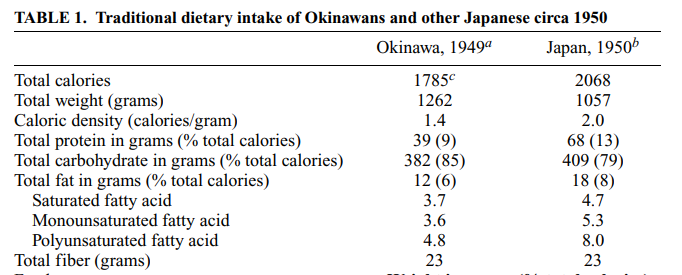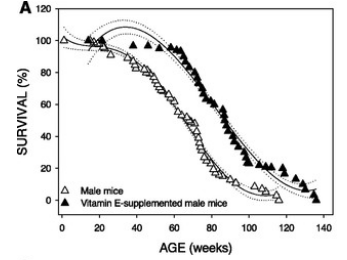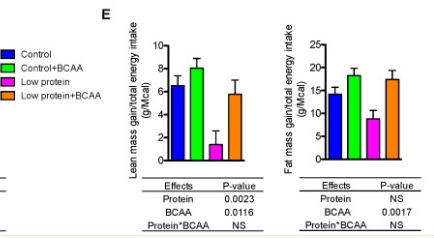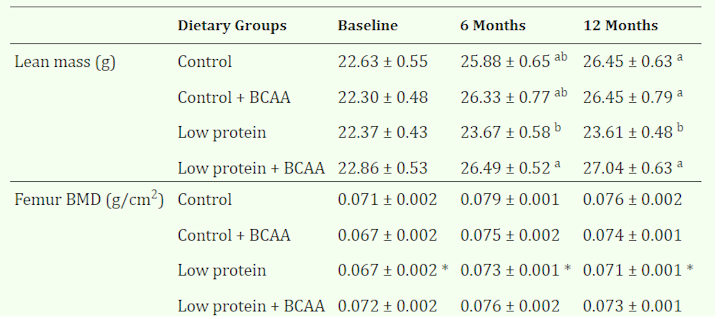Reasons for longevity in Japan?
-
Using the macro visualizer by @exfatloss you can see that 1950’s Japan and Okinawa diets consisted of shockingly high carb intake (80-85% of calories) Coming from mostly white rice and sweet potatoes. This means they ate a very low-fat (low pufa) and lowish protein diet particularly methionine/cysteine/tryptophan. This could contribute to their longevity and leanness.
-
@Serotoninskeptic
Wow, that is so interesting!Looking at the macros, they ate a very, very good diet.
In the methionine thread I've written about high carb, low protein, low fat probably being the ideal diet (but restriction 2 macros is hard) and that is pretty much what the Okinawans ate !
That also gives credit to the low protein idea being sustainable long term. Around 10% protein is what they use in a lot of studies, so that seems to be a good goal."Key nutritional biomarkers for longevity among Okinawans include lower levels of homocysteine and higher levels of antioxidant vitamins, ..."
https://en.m.wikipedia.org/wiki/Okinawa_Centenarian_Study
--> both could result from a low protein dietIirc they also have/ had higher androgens and androgenic Features than other Japanese ethnicities.
This study shows Okinawan men have higher testosterone but also higher estrogen than American men.
https://pmc.ncbi.nlm.nih.gov/articles/PMC8496353/ -
Blue zones are just a BS myth...
https://youtu.be/rB4lhT71SLo
+
https://www.dailymail.co.uk/wellness-us/article-13023311/blue-zones-healthy-life-bogus-fake-birth-certificates.html -
@Mauritio @Serotoninskeptic nice insight ty
Japanese and Okinawans were similar for averages (Okinawans had less disease too though) doi: 10.1196/annals.1396.037
(average, maximum) for Okinawans (83.8 years, 104.9 years) compared to other Japanese (82.3 years, 101.1 years),

nearly 1/2 the pufa intake , relatively high for fat % but they also ate 16mg vit E which helps counter pufa vs 6mg with the other japanese (less vit E with more pufa). 9% protein & 13%.

check this https://journals.physiology.org/doi/full/10.1152/ajpregu.00834.2004

(^ I wonder if there's some exponential element to vit E need for higher pufa intake? other studies havent replicated that with lower, and their diets typically high in pufa. but rats are usually fed high vit E as a baseline already.
extreme dose not needed to counter a lot of the pufa, especially with lower intakes seen here. both also ate >200mg vit C too i think which helps vit E function, if the other japanese ate 16mg too would it have closed the disease gap a lot? which was still much better than usa)Around 10% protein is what they use in a lot of studies, so that seems to be a good goal.
this was a good one, with 10% fat and ~80% carb diet (13% as sugar), (7% protein vs 13% vs 7% + bcaa,
they added 1.8g l-cystine to 70g casein (casein doesnt have much as only protein source, some cystine needed e.g for the sulfur reactions)(mrna expression, in liver)

https://pmc.ncbi.nlm.nih.gov/articles/PMC6073443/#sec5-nutrients-10-00918
so 10% protein in the middle would still give a fgf21 ucp1 boosttheir lean mass & bone gain suffered on 7% but some gain
yeah bumping up to 10% might be best of both


-
@Mauritio @Serotoninskeptic @cs3000
When Lindeberg examined the Kitava diet, he noticed they had a similar macronutrient ratio: ~ 70% carbs, 20% fat, 10% protein. Some fish and coconut, but mostly starchy tubers and fruit.
Do any of you remember the people Dr. Peat sometimes mentioned in interviews who ate almost nothing but potatoes/sweet potatoes all year, plus pork one week a year? He mentioned they had good muscle mass despite low protein, but I forgot whom he was talking about and I lost my notes.
-
Do any of you remember the people Dr. Peat sometimes mentioned in interviews who ate almost nothing but potatoes/sweet potatoes all year, plus pork one week a year? He mentioned they had good muscle mass despite low protein, but I forgot whom he was talking about and I lost my notes.
Could it have been the Tukisenta?
"The diet of the Tukisenta in New Guinea was studied in 1973. Their diet consists almost entirely of sweet potatoes. The Tukisenta were lean, healthy, and had little to no sign of heart disease or other diseases of civilization"
-
@Serotoninskeptic said in Reasons for longevity in Japan?:
Do any of you remember the people Dr. Peat sometimes mentioned in interviews who ate almost nothing but potatoes/sweet potatoes all year, plus pork one week a year? He mentioned they had good muscle mass despite low protein, but I forgot whom he was talking about and I lost my notes.
Could it have been the Tukisenta?
"The diet of the Tukisenta in New Guinea was studied in 1973. Their diet consists almost entirely of sweet potatoes. The Tukisenta were lean, healthy, and had little to no sign of heart disease or other diseases of civilization"
Could be. I found the interview (part 1, it starts at 16:25): https://oneradionetwork.com/dr-ray-peat-ph-d-answering-a-plethora-of-questions-regarding-health-diet-and-nutrition-january-1-2014/
Altough I didn't understand what he was saying. Something with ...inions?
Edit:
Here is another one, starting at 01:13:00. That was the interview I remembered: https://oneradionetwork.com/dr-ray-peat-ph-d-got-milk-milk-is-a-good-food-really-july-18-2019/Pacific islanders, so could be Tukisenta.
-
I am wondering if a large part of their longevity is related to the rich soil shown in the Connie Chung videos above and natural water shown in the video linked by cs3000.
Bruce Ames has a triage theory of aging.
Abstract
Inadequate dietary intakes of vitamins and minerals are widespread, most likely due to excessive consumption of energy-rich, micronutrient-poor, refined food. Inadequate intakes may result in chronic metabolic disruption, including mitochondrial decay. Deficiencies in many micronutrients cause DNA damage, such as chromosome breaks, in cultured human cells or in vivo. Some of these deficiencies also cause mitochondrial decay with oxidant leakage and cellular aging and are associated with late onset diseases such as cancer. I propose DNA damage and late onset disease are consequences of a triage allocation response to micronutrient scarcity. Episodic shortages of micronutrients were common during evolution. Natural selection favors short-term survival at the expense of long-term health. I hypothesize that short-term survival was achieved by allocating scarce micronutrients by triage, in part through an adjustment of the binding affinity of proteins for required micronutrients. If this hypothesis is correct, micronutrient deficiencies that trigger the triage response would accelerate cancer, aging, and neural decay but would leave critical metabolic functions, such as ATP production, intact. Evidence that micronutrient malnutrition increases late onset diseases, such as cancer, is discussed. A multivitamin-mineral supplement is one low-cost way to ensure intake of the Recommended Dietary Allowance of micronutrients throughout life. -
@DavidPS I noticed also in a few of the so-called "blue zones" they are drinking mineral-rich spring water that's been filtered through limestone rock, resulting in high mineral content, particularly calcium and magnesium, due to the limestone's composition. Specifically Nicoya, Costa Rica which has a high concentration of this mineral-rich limestone. Their traditional diet is also low-protein and consists of primarily peaty foods. Nixtamalized corn, black beans, yams, white rice, tropical fruits. The black beans are notably low in pufa compared to other legumes as well.
Soybeans: 5.1g/100g
Chickpeas: 2.7g/100g
Kidney Beans: 0.3g/100g
Pinto Beans: 0.2g/100g
Black Beans: 0.1g/100g -
Here is a link to a photo of Connie Chung (born 1946) and her husband Maury Povich (born 1939). The photo was taken in 2023. From the photo, do you think that she is using the fountain of youth molecule that she shilled?